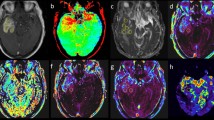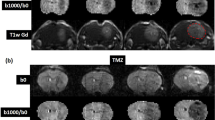Abstract
The design and evaluation of therapeutic gene transfection protocols and vectors are under extensive development. Magnetic resonance imaging (MRI) techniques can aid considerably in the development of experimental treatment approaches, as well as in determining treatment response by observing gross tissue morphology. However, through a unique set of contrast parameters, namely T1, T2, and diffusion, more information about tissue status can be obtained while delineating and classifying tumor characteristics in more detail. We show here that T1 relaxation in the rotating frame, T1ρ, provides unique in vivo MRI contrast. Ganciclovir treatment of HSV-tk+BT4C gliomas, which effectively eradicates these tumors, resulted in significantly prolonged T1ρ relaxation times in MRI already after 3 days of treatment, whereas conventional contrast parameters were elevated after 6–8 days of therapy. Interestingly, the prolonged T1ρ values were observed while an increase in tumor volume was still taking place. The regions of elevated T1ρ relaxation coincided with high apoptotic activity as determined by histology, suggesting that T1ρ MRI contrast could be used as a novel early indicator of cytotoxic cell damage in gliomas.
This is a preview of subscription content, access via your institution
Access options
Subscribe to this journal
Receive 12 print issues and online access
$259.00 per year
only $21.58 per issue
Buy this article
- Purchase on Springer Link
- Instant access to full article PDF
Prices may be subject to local taxes which are calculated during checkout




Similar content being viewed by others
References
Chiocca EA, Breakefield XO . Gene Therapy for Neurological Disorders and Brain Tumors Totowa: Humana Press 1998
Moolten FL, Wells JM . Curability of tumors bearing herpes thymidine kinase genes transferred by retroviral vectors J Natl Cancer Inst 1990 82: 297–300
Ge K, Xu L, Zheng Z, Xu D, Sun L, Liu X . Transduction ofcytosine deaminase gene makes rat glioma cells highly sensitive to 5-fluorocytosine Int J Cancer 1997 71: 675–679
Kock H, Harris MP, Anderson SC et al. Adenovirus-mediated p53 gene transfer suppresses growth of human glioblastoma cells in vitro and in vivo Int J Cancer 1996 67: 808–815
Gomez-Manzano C, Fueyo J, Kyritsis AP et al. Adenovirus-mediated transfer of the p53 gene produces rapid and generalized death of human glioma cells via apoptosis Cancer Res 1996 56: 694–699
Tseng SH, Hwang LH, Lin SM . Induction of antitumor immunity by intracerebrally implanted rat C6 glioma cells genetically engineered to secrete cytokines J Immunother 1997 20: 334–342
Moriuchi S, Oligino T, Krisky D et al. Enhanced tumor cell killing in the presence of ganciclovir by herpes simplex virus type 1 vector–directed coexpression of human tumor necrosis factor-alpha and herpes simplex virus thymidine kinase Cancer Res 1998 58: 5731–5737
Holmgren L, O'Reilly MS, Folkman J . Dormancy of micrometastases: balanced proliferation and apoptosis in the presence of angiogenesis suppression Nat Med 1995 1: 149–153
Ram Z, Culver KW, Oshiro EM et al. Therapy of malignant brain tumors by intratumoral implantation of retroviral vector–producing cells Nat Med 1997 3: 1354–1361
Sandmair AM, Loimas S, Puranen P et al. Thymidine kinase gene therapy for human malignant glioma, using replication-deficient retroviruses or adenoviruses Hum Gene Ther 2000 11: 2197–2205
Poptani H, Puumalainen A-M, Gröhn OHJ et al. Monitoring thymidine kinase and ganciclovir-induced changes in rat malignant glioma in vivo by nuclear magnetic resonance imaging Cancer Gene Ther 1998 5: 101–109
Hakumäki JM, Poptani H, Puumalainen A-M et al. Quantitative 1H NMR diffusion spectroscopy of BT4C rat glioma during thymidine kinase–mediated gene therapy invivo: identification of apoptotic response Cancer Res 1998 58: 3791–3799
Izquierdo M, Cortes M, De Felipe P et al. Long-term rat survival after malignant brain tumor regression by retroviral gene therapy Gene Ther 1995 2: 66–69
Chenevert TL, McKeever PE, Ross BD . Monitoring early response of experimental brain tumors to therapy using diffusion magnetic resonance imaging Clin Cancer Res 1997 3: 1457–1466
Hakumäki JM, Poptani H, Sandmair A-M, Ylä-Herttuala S, Kauppinen RA . 1H MRS detects polyunsaturated fatty acid accumulation during gene therapy of glioma: implications for the in vivo detection of apoptosis Nat Med 1999 5: 1323–1327
Ross BD, Chenevert TL, Kim B, Ben-Yoseph O . Magnetic resonance imaging and spectroscopy: application to experimental neuro-oncology Q Magn Reson Biol Med 1994 1: 89–106
Evelhoch JL, Gillies RJ, Karczmar GS et al. Applications of magnetic resonance in model systems: cancer therapeutics Neoplasia 2000 2: 152–165
Sepponen RE, Pohjonen JA, Sipponen JT, Tanttu JI . A method for T1ρ imaging J Comput-Assisted Tomogr 1985 9: 1007–1011
Rommel E, Kimmich R . T1ρ dispersion imaging and volume-selective T1ρ dispersion weighted NMR spectroscopy Magn Reson Med 1989 12: 390–399
Menon RS, Allen PS . Solvent proton relaxation of aqueous solutions of the serum proteins α2-macroglobulin, fibrinogen, and albumin Biophys J 1990 57: 389–396
Mäkelä H, Gröhn OHJ, Kauppinen RA . Effects of pH and ionic environment on the on-resonance T1ρ in native and cross-linked protein solution as determined with spin-lock methods Prog Int Soc Magn Reson Med 2000 8: 513
Kettunen MI, Gröhn OHJ, Penttonen M, Kauppinen RA . Cerebral T1ρ relaxation time increases immediately upon global ischemia in the rat independently of blood glucose and anoxic depolarization Magn Reson Med 2001 46: 565–572
Gröhn OH, Lukkarinen JA, Silvennoinen MJ, Pitkänen A, van Zijl PC, Kauppinen RA . Quantitative magnetic resonance imaging assessment of cerebral ischemia in rat using on-resonance T1 in the rotating frame Magn Reson Med 1999 42: 268–276
Gröhn OHJ, Kettunen MI, Mäkelä HI et al. Early detection of irreversible cerebral ischemia in the rat using dispersion of the MRI relaxation time, T1ρ J Cereb Blood Flow Metab 2000 20: 1457–1466
Paxinos GT, Watson C . The Rat Brain in Stereotaxic Coordinates New York: Academic Press 1996
Garwood M, Ke Y . Symmetric pulses to induce arbitrary flip angles with compensation for RF inhomogeneity and resonance offsets J Magn Reson 1991 94: 511–525
Mori S, van Zijl PCM . Diffusion weighting by the trace of the diffusion tensor within a single scan Magn Reson Med 1995 33: 41–52
Buonanno FS, Brady TJ, Pykett IL et al. Proton NMR imaging in experimental ischemic cerebral infarction Ann Neurol 1981 10: 75
Sridharan KR, Schreiner LJ, Kydon DW, Pintar MM, Inch WR . Characterization of normal and malignant mouse tissue by NMR lineshape relaxation correlations in the rotating frame Magn Reson Med 1985 2: 73–70
Poptani H, Duvvuri U, Miller GG et al. T1ρ imaging of murine brain tumors at 4T Acad Radiol 2001 8: 42–47
Duvvuri U, Poptani H, Feldman M et al. Quantitative T1ρ magnetic resonance imaging of RIF-1 tumors in vivo: detection of early response to cyclophosphamide therapy Cancer Res 2001 61: 7747–7753
Chenevert TL, Stegman LD, Taylor JM et al. Diffusion magnetic resonance imaging: an early surrogate marker of therapeutic efficacy in brain tumors J Natl Cancer Inst 2000 92: 2029–2036
Koenig SH, Brown RD III, Ugolini R . A unified view of relaxation in protein solutions and tissue, including hydration and magnetization transfer Magn Reson Med 1993 29: 77–83
Mills JC, Stone NL, Pittman RN . Extranuclear apoptosis. The role of the cytoplasm in the execution phase J Cell Biol 1999 146: 703–708
Wolf CM, Eastman A . Intracellular acidification during apoptosis can occur in the absence of a nucleus Biochem Biophys Res Commun 1999 254: 821–827
Mäkelä H, Gröhn OHJ, Kettunen M, Kauppinen RA . Proton exchange as a relaxation mechanism for T1 in the rotating frame in native and immobilized protein solutions Biochem Biophys Res Commun 2001 289: 813–818
Ronen SM, DiStefano F, McCoy CL et al. Magnetic resonance detects metabolic changes associated with chemotherapy-induced apoptosis Br J Cancer 1999 80: 1035–1041
Bernardi P, Petronilli V, Di Lisa F, Forte M . A mitochondrial perspective on cell death Trends Biochem Sci 2001 26: 112–117
Stegman LD, Rehemtulla A, Hamstra DA et al. Diffusion MRI detects early events in the response of a glioma model to the yeast cytosine deaminase gene therapy strategy Gene Ther 2000 7: 1005–1010
Moseley ME, Cohen Y, Mintorovitch J et al. Early detection of regional cerebral ischemia in cats: comparison of diffusion- and T2-weighted MRI and spectroscopy Magn Reson Med 1990 14: 330–346
Adebodun F, Post JFM . 31P NMR characterization of cellular metabolism during dexamethasone induced apoptosis in human leukemic cell lines J Cell Physiol 1994 158: 180–186
Williams SN, Anthony ML, Brindle KM . Induction of apoptosis in two mammalian cell lines results in increased levels of fructose-1,6-bisphosphate and CDP-choline as determined by 31P MRS Magn Reson Med 1998 40: 411–420
Sammet S, Bock M, Schlemmer H-P, Bachert P . Fast T1ρ NMR imaging and relaxometry of brain tumors in patients at 1.5T Proc Int Soc Magn Reson Med 2000 8: 1097
Acknowledgements
This study was supported by the Academy of Finland, The Finnish Cancer Societies, Sigrid Juselius Foundation, and Emil Aaltonen Foundation. Technical assistance by Ms Nina Kuhmonen and Ms Mervi Riekkinen is gratefully acknowledged.
Author information
Authors and Affiliations
Corresponding author
Rights and permissions
About this article
Cite this article
Hakumäki, J., Gröhn, O., Tyynelä, K. et al. Early gene therapy–induced apoptotic response in BT4C gliomas by magnetic resonance relaxation contrast T1 in the rotating frame. Cancer Gene Ther 9, 338–345 (2002). https://doi.org/10.1038/sj.cgt.7700450
Received:
Published:
Issue Date:
DOI: https://doi.org/10.1038/sj.cgt.7700450
Keywords
This article is cited by
-
Quantification of myocardial infarct area based on TRAFFn relaxation time maps - comparison with cardiovascular magnetic resonance late gadolinium enhancement, T1ρ and T2 in vivo
Journal of Cardiovascular Magnetic Resonance (2018)
-
Dispersion of cerebral on-resonanceT 1 in the rotating frame (T 1ρ) in global ischaemia
Applied Magnetic Resonance (2005)
-
Noninvasive estimation of tumour viability in a xenograft model of human neuroblastoma with proton magnetic resonance spectroscopy (1H MRS)
British Journal of Cancer (2003)



